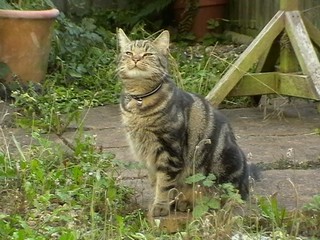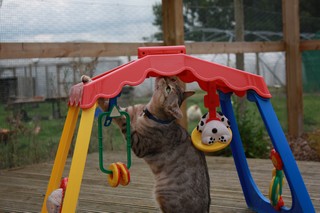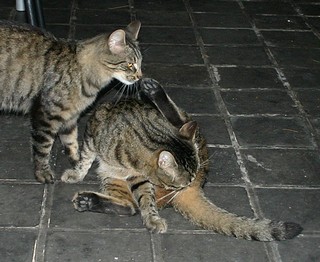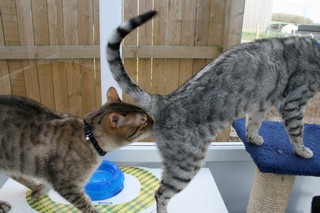Sniff
Sniffing is a series of rapid, short inhalations and exhalations which force air into the nasal passages. The air is trapped within the nasal passages instead of passing into the lungs as in normal breathing. This allows the scent molecules within the trapped air to interact with the olfactory receptors within the nose (Case, 2003).
The rapid, short inhalations cause the cat's nose and upper lip to twitch as seen in this video clip. Sniff airWhen investigating a scent carried on the air the cat will orientate its head in the direction of the scent, often raising its head to sniff as seen in the photo above. Sniff objectWhen investigating an object the cat may sniff it. To do this the cat brings its nose close to the object and sniffs as described in "sniffing" . The cat may alter the position of its body in order to bring its nose as close as possible to the source of the smell.
Both familiar and unfamiliar cats may be investigated through sniffing, however the action differs in the two social situations. When investigating a familiar and affiliative cat, the cats will often sniff each other's nose and face area, sometimes following with a sniff of the rear end. Sniffing of other areas of the body may also occur during interactions as shown in this photograph.
When in close proximity to a conspecific, a cat may bring its head close to the other cat and sniff, as seen in this video clip. When sniffing an unfamiliar cat the body posture shown is usually indicative of increased muscular tension and neck extension towards the cat being sniffed may be exhibited. In courting behaviour, the male will sniff the rear end of the female (see courtship behaviour).
Cats may also sniff animals of a different species. If they are cautious of the item (living or non-living) that they wish to investigate by sniffing, the neck may often be elongated, keeping the body as far away from the source of the smell as possible. In the video below you can see all the cats sniffing each other, sniffing the environment, the air and the food source. Sniff eliminationCats usually sniff the substrate they have chosen as their latrine immediately prior to elimination (urination or defaecation). Sniffing is also common after elimination and incorporates both sniffing the soiled substrate and the surrounding substrate. Sniffing post elimination usually occurs in short bouts interspersed with burying/covering of the soiled substrate In the video below you can watch a cat sniffing a litter tray post elimination which is a normal part of the elimination sequence that is frequently seen. |
|||||||||||||

Compiled by:
Dr Sarah Ellis, Helen Zulch and Jenna Kiddie



